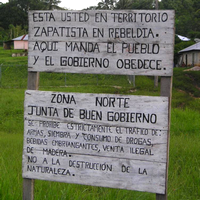In the first light of dawn on New Year's Day 1994, indigenous campesinos wearing ski masks and toting assault weapons stormed major towns in the southeastern Mexican state of Chiapas. By midday, the Zapatista Army of National Liberation (EZLN, in Spanish) had introduced itself to the world as the new face of social revolution.
The nature of this face -- or more accurately, the lack thereof -- immediately distinguished the movement. Black balaclavas, worn at all times in public, along with the rugged attire of the indigenous population, captivated the lenses of the world's media. So did the eloquent dispatches explaining the need for the movement's existence -- and for the masks. "In order for them to see us, we covered our faces; so that they would call us by name, we gave up our names; we bet the present to have a future; and to live . . . we died," its leadership would later explain.
In the midst of this surprising group stood a tall, light-skinned man. Fluent in Spanish, French and English, as well as local dialects, he immediately became a focal point of the movement, and of numerous media rumors. When first asked who exactly he was, he did his best James Bond imitation, replying through his balaclava, "Marcos. Subcomandante Marcos." The use of playful irony would soon define the persona he developed to address the serious issues facing his movement in frequent media appearances, interviews and through the official communiqués attributed both to him and to the Zapatistas in general. Sixteen years later, Subcomandante Marcos has yet to reveal his true identity, and denies any and all speculation about it.

